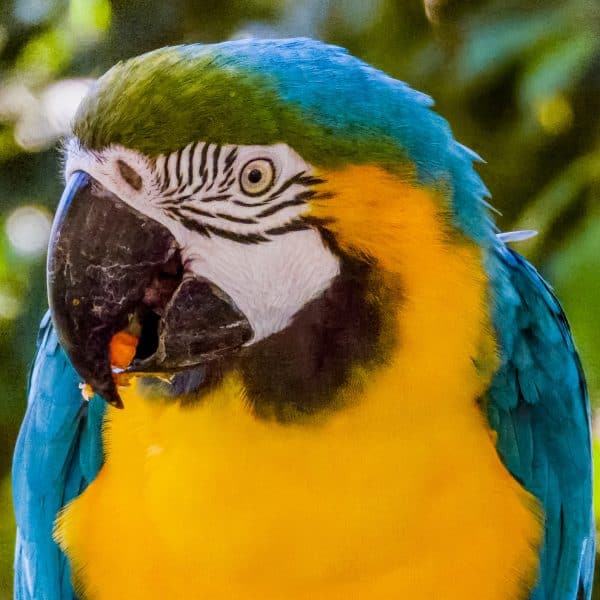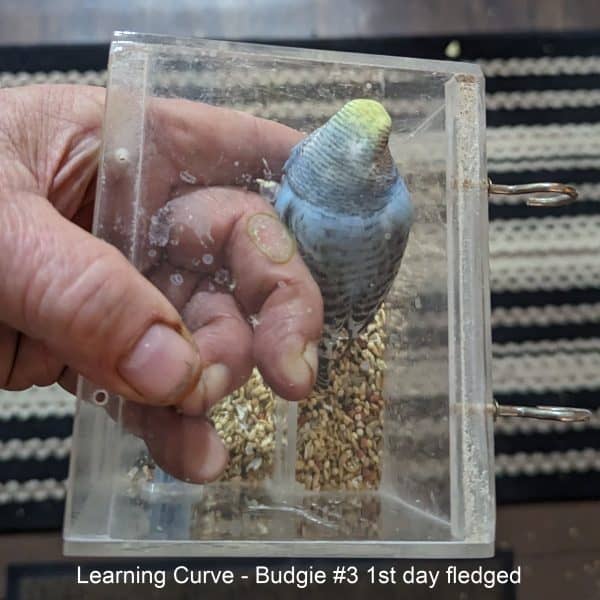
This Lovebird Mom’s Opinion of Birdcage Accessory Placement
Last Updated on by Catherine Tobsing
From Marla S.
Hi, Your toys, treats, and perch setup are nice. Not overcrowded and is laid out nicely. One comment though.
As a Lovebird Mom for over nine years now It baffles me to this day to see other bird parents place their bird’s open food and water dishes on the cage floor!
This is in the direct path of the bird’s droppings! Would you place your human child’s food and water dishes at the bottom of the toilet? No.
Why then would you put your bird children’s food and water dishes in the place where their feces would be dropped into them????
For sanitation reasons I hang a double feeding trough with an inserted feeding dish on each side; one for water and one for Harrison’s Organic High Potency food.
The food is changed daily and their water dishes are cleaned and changed twice a day with filtered water. This way their feces drop to the cage bottom and their filtered water and food don’t get contaminated!
Keeping our little dependent feathered kids healthy is every bird parent’s top priority, right? Thank you.
Hi Marla
Nature designed bird poop to help carry seed (and fish eggs) across the land to help propagate earth which is why birds are so messy. They don’t know the difference between the rainforest canopy and your Pergo floor.
Budgies are ground eaters so it’s more natural for them to eat on the ground. If you look at any of the cages I’ve set up (hundreds), not a toy, food dish perch, or ladder ever gets pooped on from above.
Our Senegal eats from a conventional food dish. We take into consideration every nuance of the species when cage set-up time arrives. The more time a bird spends in a cage, the more often the cage needs to be arranged to challenge the bird against boredom.
Every square inch of a cage is in the direct path of the cage floor. Lovebirds are unique because they like to hang on the walls of the cage while engaging toys where as other birds prefer to stand on a perch while doing so. Thus I will cagescape a lovebird’s cage much differently than a cockatiel’s or a Quaker’s cage.
Sometimes it may take a couple of weeks but to your point, birds will clean their feet with their beak and tongue so you don’t want them walking through poop at any level or accessory in the cage.
Soiled toys and accessories also take longer to clean.
Let’s back up. There is no one-size-fits-all for birdcage toys and accessory placement.
Years ago I coined the term “cagescaping” which never caught on but I still use it.
Much like landscaping everything from the size shape and interior height of the cage has to be taken into consideration as well as the species.
Bird toys hung in the middle of the cage from the top might look pretty but they are not necessarily accessible to a bird unless the bird hangs from the top of the cage to engage the toy.
Some birds have suffered a terrible fate by getting stuck on a toy in the middle of the cage and not knowing how to get off. As a result, they inadvertently forego food and water which could lead to dehydration and or death.
Even though Peaches our Senegal resides in the same cage that Popcorn our cockatiel did we had to make many changes.
Perches bolted to the side of the cage could be moved closer towards the back of the cage because a Senegal has a shorter tail than a cockatiel.
This allowed a cluster of toys that at the time our new bird who spent 22 hours a day in a cage at a rescue, could hide behind and feel safe in her new surroundings.
Some pet bird keepers mistakenly put perches too close to the back of the cage so a longtail bird never uses it because the tail is always rubbing against the bird cage bars.
We prefer to place most of the bird toys along the walls of the cage in the upper third. We place them in groups using booda rope perches leading to the bird toy group but knowing motivated birds are more than willing to hang from the cage bars or the toy itself.
We advocate two or three Booda Comfy rope perches in every cage one of which being the perch your bird sleeps on because it’s soft and doesn’t wear on the feet.
Other perches like Manzanita and Coffee wood, which is very durable having irregular surfaces thereby challenging the bird’s foot
We had one toy in the breakfast club’s cage that Bacon would just relentlessly attack. We thought he didn’t like where it was because it may have been blocking other toys so we moved it from the side of the cage to the back of the cage.
Bacon still grabs a little toy and thrashes it endlessly like he’s mad at it. It’s always hard to tell what goes on in the mind of the little bird.
Birdcages should be considered organic living spaces not static boxes with the same toys and accessories that reside forever.
For birds that are caged many hours a day, it is highly recommended that you remove everything from the cage at least once a month not only allowing you to clean all the toys and accessories but to put them back in all new places to keep your bird challenged and mentally alert.
The more you present change to your bird the more readily it will accept change and it’s true with anything including its food, your travel habits in the introduction of human socialization.
Feathered factoid: Birds are one of the only species that are not affected by eating habanero peppers regardless of how “hot” they are. Nature did this so birds could spread the seeds of the habanero pepper plants because other animals would have nothing to do with them.
Besides long tails, the bird with clipped wings can live and no more crowded cage as long as he or she can flap their wings.
If you trim your bird’s nails on a regular basis, perch surfaces need to be a little rougher, or vet rap needs to be added so bird doesn’t accidentally slip off the perch and hurt itself until the nails can get clingier.
We use romaine lettuce not only as a foraging and enrichment item but use it to help change the bird’s environment.
Toys don’t have to be something that always hangs from the cage but materials like braided palm can be woven in and out of the cage bars to create privacy while offering foraging opportunities.
We have a little toy in the budgie’s cage, a basketball, and a basketball net. Originally I put some crumbled Nutri-berries in the basket, put the ball in the basket, and covered the ball with more Nutri-berries.
It wasn’t until I left the ball uncovered that they realized they could pull the ball out to access the nutritious treats sitting in the net.
We keep at least two food dishes and two water feeders available because we have multiple birds in a single cage in don’t want jealousy to lock somebody out of food and water.
We specifically use this Millet holder because the birds enjoy eating their millet communally.
All of our cages have a thermo perch which provides the bird a choice to seek warmth, especially after bathing.
When practical we like to place a grooming perch next to a food dish. Birds are active in their eating so their nails will get ground a little and they have a surface to rub their beak removing particulate that may bother them after eating.
Feathered factoid: although birds’ beaks appear to be a solid piece of keratin, they’re quite sensitive with many nerves called Herbst corpuscles.
Rubbing a bird’s beak may be sexually stimulating so it’s best to avoid sticking only to the top of the head down to the neck.
If you have a female bird or small birds it’s good to offer a cuttlebone, remembering to keep the soft side toward the inside to help supply additional calcium which is depleted when they go through any sort of brooding.
Many toys come with seashells or calcium treat pieces like Prevue Pet Cookies and Knots
All birdcages should have a full spectrum light with or without UVA and UVB. The light should be no further than 1 foot over the cage and on a timer set for 12 hours of light and 12 hours of darkness.
Birds know exactly what time it is and expect an equatorial-type light cycle. The bird should be in the cage when the light turns on and turns off helping indicate when the day starts and ends helping them keep those little circadian oscillators oscillating at the right speed.
Time light over the cage is a small accessory with a huge impact in can help a bird maintain its sanity. The changing North American light cycles, regardless of how much son your bird gets during the day, stress are birds out.
Written by Mitch Rezman
Approved by Catherine Tobsing
Author Profile
Latest entries
 The Traveling BirdJune 26, 2025Can You Name 5 Parrot Species That Are Living Wild in the USA?
The Traveling BirdJune 26, 2025Can You Name 5 Parrot Species That Are Living Wild in the USA? Bird BehaviorJune 26, 2025How is it Parrots Are Problem Solvers Social Animals and Even Use Tools?
Bird BehaviorJune 26, 2025How is it Parrots Are Problem Solvers Social Animals and Even Use Tools? Bird & Parrot AnatomyJune 25, 2025How a Tiny Chemical Modification Makes Parrots Nature’s Living Paintings
Bird & Parrot AnatomyJune 25, 2025How a Tiny Chemical Modification Makes Parrots Nature’s Living Paintings PigeonsJune 20, 2025How Do Parrots Thrive in Cities Outside Their Native Habitats?
PigeonsJune 20, 2025How Do Parrots Thrive in Cities Outside Their Native Habitats?


